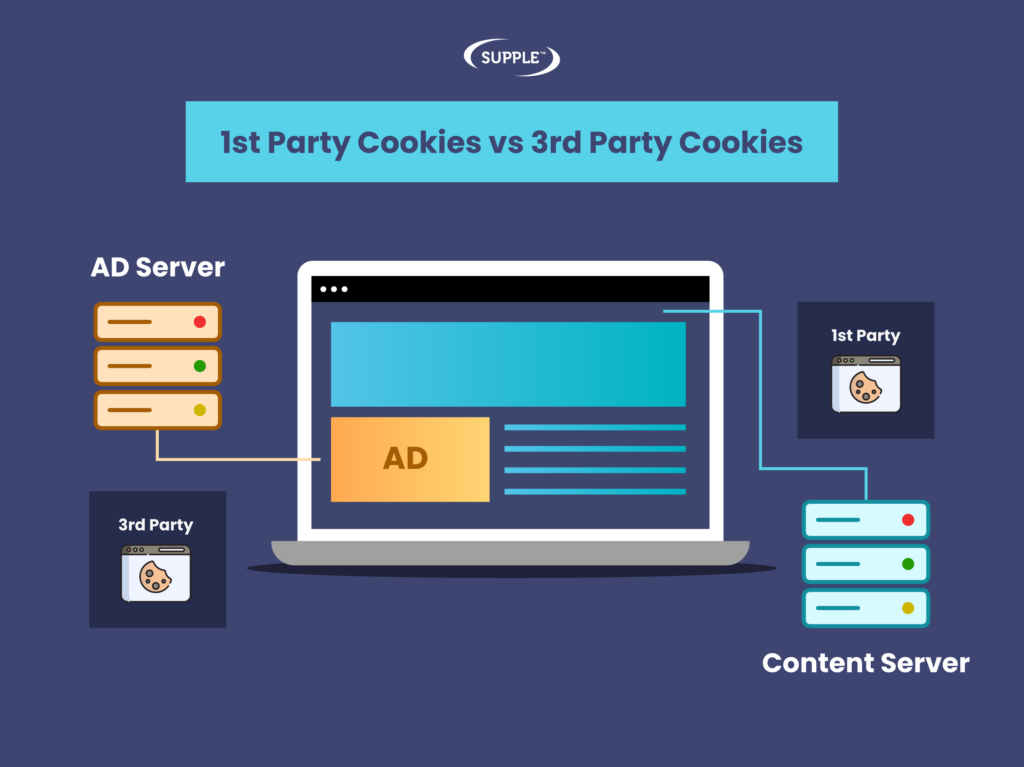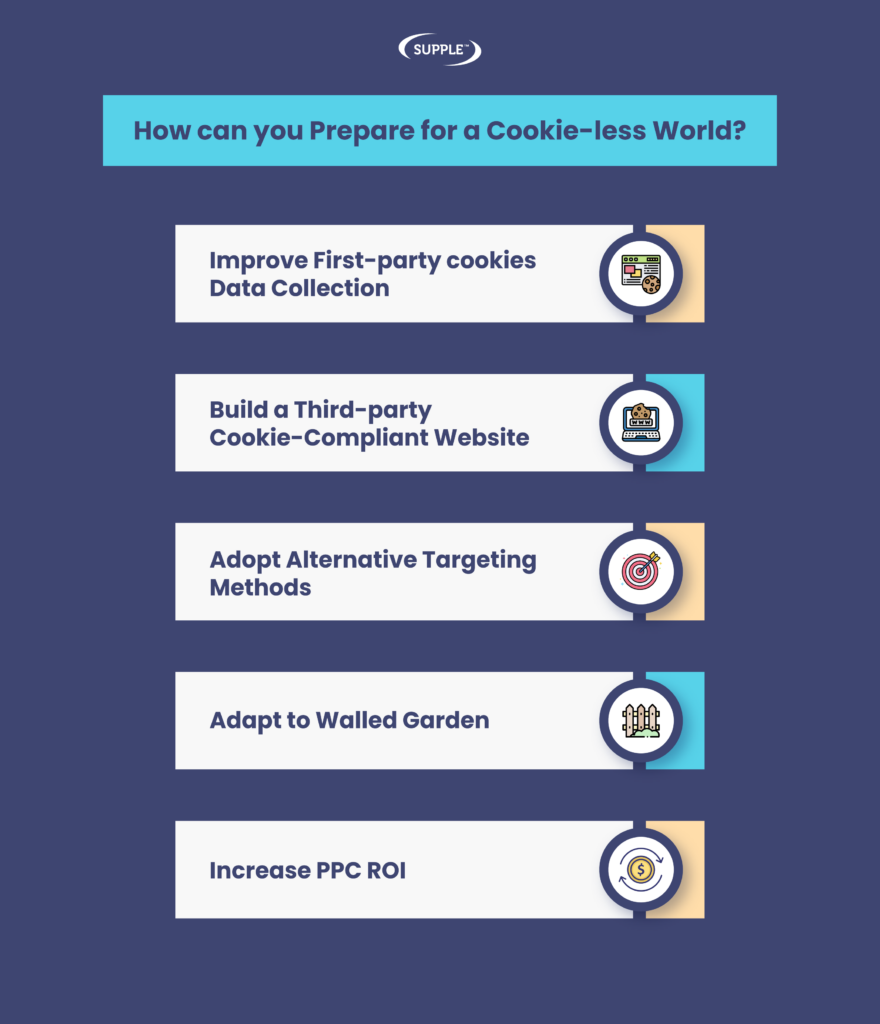What does a cookie-less world look like for your business website?
The time has come.
The inevitable doom of third-party cookies.
Google has finally decided to discontinue third-party cookies due to data privacy concerns.
Why finally? Other browsers like Safari, Edge, and Firefox have already blocked third-party cookies for the same reasons.
This news hits marketers and advertisers the hardest as they significantly rely on third-party cookie data to track and re-target site visitors. Almost 60% of senior executives also believe that losing third-party cookies will disrupt their marketing efforts.
So what now for marketers who are at crossroads and wondering how to build campaigns in a cookie-less world?
Let’s find out.
An Overview of the Cookie-less World
Google recently announced that it will be discontinuing third-party cookies from 2024 on the Google Chrome Browser. It has already started with its testing phase where Chrome restricted third-party cookies for 1% of users from January 4th, 2024. It eventually will restrict cookies for 100% of its users from the third quarter of 2024.
Initially, Google aimed to remove third-party cookies from the Chrome browser sometime in 2022. It then postponed the deadline to 2023 and is now finally settled for the second half of 2024. One of the major reasons for this delay can be attributed to giving time for marketers to readjust their personalised marketing strategies.
Marketers who keep up with the news must’ve seen this coming, considering that other browsers have already dismantled the third-party cookie systems. What Google aims to achieve by this is to reduce cross-site tracking and address the privacy concerns of its users but still have first-party cookies to keep the functionality of the site intact.
What are Cookies?
To understand third-party cookies, you first need to understand cookies in general and how they play a role in privacy and data protection. Cookies are a text file that contains information about the users and are collected by the browsers.
This data is created by the server upon your connection and is labelled with an ID unique to the user and their computers/devices. What they essentially do is track user behaviour on the website and remember their preferences.
Some of these practices have resulted in numerous privacy concerns as many international laws like the EU’s General Data Protection Regulation (GDPR), and certain state laws, like the California Consumer Privacy Act (CCPA), require websites to seek permission and inform users on how their information will be used if you decide to accept the request.
While this explains the concept of cookies in general, there are two types of cookies where one isn’t as villainous as the other. Let’s take a look at them in detail.
- First-party Cookies
First-party cookies are also known as essential cookies. They are stored on the users’ browsers directly from the website they’re visiting. The motive of these cookies is to improve the site functionality and user experience. And as you might’ve guessed, they’re the good ones and not as controversial as third-party cookies.
First-party cookies help websites retain account information, collect login data, remember language preferences, settings, etc and help websites provide a good user experience.
See?
Completely harmless stuff.
First-party cookies don’t follow users around the internet to collect personal information about users.
And when we talk about a cookie-less world, it doesn’t include first-party cookies as they are “essential” to a website’s effectiveness and functionality.

- Third-party cookies (Non-Essential Cookies)
Third-party cookies are definitely the more problematic of the two and are what prompted websites to eliminate them. Third-party cookies are also called non-essential cookies and are called so because they are set by a domain other than the one you’re on. These text files allow a third-party site to track a user’s browsing behaviour on a particular website. They contain a unique identifier called a cookie ID that is linked to an individual.
For example, say a user searched for a healthcare facility in Australia. The users’ screen will have multiple pop-ups about healthcare facilities in Australia on multiple websites, especially on social media platforms like Facebook. This happens because the web browser stores a third-party cookie and leverages this information to send targeted ads to websites.
Similarly, third-party cookies inform brands of visitor information on external websites such as their interests, purchase history, location, and frequented sites. This information is further used by marketing departments and ad agencies to track user journeys as third-party cookies follow users around the internet.
Why are Cookies Going Away?
When marketers got the freedom to advertise their products on the internet using data from cookies, it felt like a major win for personalised marketing campaigns. They could easily retarget customers and catch them right where they were on the buying journey.
But sadly, customers don’t see it that way. What marketers think of as retargeting, customers see them as creepy marketing gimmicks that compromise their privacy on the web.
As customers evolve, Google believes there needs to be an agreed-upon set of standards to improve user privacy without unintended consequences. That is what led Google to announce the Privacy Sandbox — a less intrusive solution to targeted advertising.
The Third-party Cookie Controversy – Where is the Privacy?
The practice of collecting data using third-party cookies has been questioned for a while now. Simply because there has been a growing concern amongst users for their privacy and it even goes against numerous national and international privacy laws.
While marketers leverage the data to improve personalised marketing, users feel a lack of control over their online presence. And that’s the primary difference between first-party cookies and third-party cookies. A brand’s website owns the first-party data as they come from your own channels and information is gathered with consent.
Besides, data protection laws like the General Data Protection Regulation (GDPR) require users to consent to cookies and many users simply agree to the consent out of habit and convenience.
A lot of times, users have to manually click the cookie banner and click on the “Reject All” option. For some, this seems too much work and for others, they don’t even know this option exists.
In any case, these practices are invasive and keep the ball majorly in the marketers’ court. Hence, all the more reason for a cookie-less world.
This has posed a new challenge for marketers — how to continue to personalise and target in a cookie-less world? What are the steps they can take to move forward with first-party cookies? And what’s next for personalised marketing?
How can you Prepare for a Cookie-less World?

- Improve First-party cookies Data Collection
Considering that a cookie-less world still has first-party cookies, you make do with what you have in the best possible manner. As we bid adieu to third-party cookies, first-party cookies will become the primary source of data for marketers.
There’s also another form of data called zero-party data termed by Forrester Research. It is the data that the consumer willingly shares with you such as personal contexts, filters, purchase intentions, and pricing details set by the user.
To improve first-party data collection, it’s time you consider implementing advanced analytics on your website. This helps you understand user behaviour and improve your CRM process. While you cannot go against the privacy laws to create personalised marketing campaigns, you can at least be transparent about what data you’re collecting and why you’re doing so.
To make your first-party cookies more effective, consider making iterations on how to collect user data. Some tips you can consider are:
Conducting a data collection audit: Is your first-party cookie data comprehensive? If not, then make it. Ensure that when gathering information from website visitors, you’re prioritising key details such as age, range, location, preferences, and interests.
Assess the existing data sets: Even with simple website visits, you can generate numerous customer insights that you previously overlooked. Analyse the data from social media marketing analytics, do heatmap analysis, focus on user intent to improve SEO, and leverage data from your CRM. If all the necessary first-party data marketing tools are in place, you wouldn’t have to rely too heavily on third-party data.
Identify and fill data gaps: Look for places and instances where you can gather more data on your website and add the necessary tools to help you better understand your customer needs and preferences.
- Build a Third-party Cookie-Compliant Website
While you redirect all your efforts to first-party cookies, you need to actively consider making your site third-party cookie-compliant. That essentially means blocking third-party cookies, becoming more transparent with website visitors and complying with new consent requirements.
Although there’s still time to make these adjustments, you should set it up sooner than later. Some of the actions you can take are:
Share your Privacy Policy: Be clear to your users about how you collect, use, and store their data. Keep the policies accessible and write them in simple language so that users can understand them quickly.
Prioritise Consent Management: Third-party cookies compromise on consent and this is something most websites will have to work on. You need to give your audience the power of consent and offer personalised options for specific purposes.
Don’t make it a Compulsion: For users who aren’t interested in sharing their data, give them the option to opt out. That’s the whole point of asking for consent. Even if they don’t give it, provide a means for users to experience your site without data collection.
- Adopt Alternative Targeting Methods
One major reason marketers loved third-party cookies was because they helped with targeting website visitors. But there are other less-intrusive ways to do so. Let’s check them out.
Contextual Targeting
Just like Google prioritises sites with context-based content and keyword targeting in SEO, you can do the same with your ad campaigns. It means to display ads based on page content instead of their user profiles or past behaviour.
For example, if you’re a Shopify store that sells shoes in Melbourne, you can target a sports website or articles about running and athletes. It essentially means reaching out to the audience where they want to spend their time.
But to truly ace such campaigns, it’s important to do clear audience profiling, and understand their interests, the content they consume, and the platforms they frequent.
Cohort-based Advertising
Cohort-based advertising groups similar (cohorts) attributes such as location, age, and interests and deliver personalised ad campaigns without tracking each individual. It is also a solution proposed by Google under the “Federated Learning of Cohorts (FLoC).”
The motive of FLoC is to replace cookies with an API built into the browser. The individual user data is anonymised and Chrome will group the users based on their common interests and browsing habits.
A cohort can include a segment of customers who all bought sports shoes, or everyone who purchased a product from a website in a particular time frame, etc. These groups are then targeted with similar content marketing techniques and PPC campaigns.
- Adapt to Walled Garden
As we move towards a cookie-less world, you can familiarise yourself with the ‘walled garden’ for targeted advertising. It is an ad platform where you deal directly with platforms and publishers and they handle all the buying, serving, tracking, and reporting.
These publishers are mostly the platform giants like Google, Facebook, and Amazon who already have access to massive amounts of first-party user data.
The publishers own the entire ad platform and are likely to become the primary source of data as everyone shifts to cookieless advertising.
The platforms leverage first-party data targeting and self-serve advertiser portals. Marketing teams will need to build better relationships with these exclusive advertisers and prioritise media and resource investments and data capabilities accordingly.
Prepare for a Cookie-less World with Supple
The cookie-less world is the world of the future and this will significantly affect brand’s marketing and social media marketing strategies. For every campaign, your data will be difficult to source considering you want the campaigns to be as personalised as possible.
But just because you’re saying goodbye to cookies, doesn’t mean you need to say goodbye to personalised marketing campaigns. You can still leverage first-party data and build direct user relationships whilst adhering to privacy regulations and securing consumer data.
Supple can help you with all your cookie-less marketing campaigns and run marketing campaigns for tomorrow. Contact us on how we can help you execute advanced digital marketing strategies by leveraging legitimate data and targeting the right kind of audience.
DIGITAL MARKETING FOR ALL OF AUSTRALIA
- SEO AgencyMelbourne
- SEO AgencySydney
- SEO AgencyBrisbane
- SEO AgencyAdelaide
- SEO AgencyPerth
- SEO AgencyCanberra
- SEO AgencyHobart
- SEO AgencyDarwin
- SEO AgencyGold Coast
- We work with all businesses across Australia


